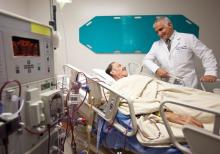Ultrafiltration Adds to Options for Hard-to-Treat Heart Failure
VANCOUVER, B.C. – Ultrafiltration is expanding treatment options for selected patients with heart failure, such as those with refractory congestion or renal dysfunction, according to experts in the field.
"The current therapy of heart failure is still the same as we have had for many, many, many years," Dr. Amir Kazory told attendees at the congress sponsored by the International Academy of Cardiology. This therapy relies heavily on intravenous diuretics.
But 49% of patients hospitalized for heart failure and treated with such standard care lose little or no weight (an indicator of fluid retention) or actually gain some by the time they are discharged.
Added to that, many patients who enter the hospital without renal problems and receive standard therapy develop acute kidney injury during their stay, with an accompanying increased risk of death (Eur. J. Heart Fail. 2010;12:32-37).
"These two things together [limited efficacy and renal complications] have been the basis for trying to find ways other than our standard therapy," noted Dr. Kazory, who is a nephrologist at the University of Florida, Gainesville. "One of them would be ultrafiltration therapy."
Use of ultrafiltration in patients with heart failure is hardly new, dating back as far as the 1940s, he said. But interest in this therapy has increased with the Food and Drug Administration’s approval of a portable device for isolated ultrafiltration that has a simple design (Aquadex FlexFlow System). It is marketed for use by non-nephrologists, and can be used in settings other than intensive care units and dialysis centers.
Dr. Kazory noted that most studies of ultrafiltration in patients with congestive heart failure have found that it improves clinical outcomes (Cardiology 2001;96:144-54). Moreover, it has a number of advantages when compared with diuretics (Circulation 2008;117:975-83).
One advantage is that ultrafiltration allows more rapid removal of fluid and improvement of symptoms in volume-overloaded patients. For example, in the UNLOAD trial – the largest trial of ultrafiltration therapy to date, involving 200 patients – those treated with ultrafiltration lost about 5 kg of weight in 48 hours, whereas their counterparts treated with intravenous diuretics lost 3 kg (J. Am. Coll. Cardiol. 2007;49:675-83.
Ultrafiltration also allows comparatively higher mass clearance of sodium. And the fluid and sodium removal is achieved with a lower risk of electrolyte perturbations such as hypokalemia.
"We probably remove a lot of proinflammatory cytokines with ultrafiltration, something that does not happen with diuretics," Dr. Kazory continued. "This is probably why patients come back to the hospital less frequently when they are ultrafiltrated." And removal of these cytokines also has the potential to restore responsiveness to diuretics.
The clinical benefits of ultrafiltration appear to be sustained over time, too. For example, in the UNLOAD trial, just a single session of ultrafiltration reduced the rehospitalization rate for heart failure over the next 90 days relative to intravenous diuretics.
Tempering all of these merits of ultrafiltration, there are still a number of unanswered questions and concerns, acknowledged Dr. Kazory.
For example, it is unclear if ultrafiltration has any renoprotective effect. Indeed, studies to date suggest that creatinine levels improve minimally if at all with this therapy (Heart 2009;95:1047-51). "At least we can say it didn’t get worse," he commented. "With diuretics, we expect it to be a little worse, especially with high-dose diuretics."
The impact of ultrafiltration on long-term morbidity and mortality is a key uncertainty, especially given that this therapy activates certain cytokines.
"There is no mortality data on ultrafiltration so far," Dr. Kazory noted. But levels of markers of mortality, such as blood urea nitrogen and serum sodium, suggest that there is no major change in these markers with ultrafiltration (Int. J. Cardiol. 2010;143:1-3).
The cost-effectiveness of ultrafiltration therapy is also unknown at present. Although it is clearly more expensive than diuretics up front, it may be less expensive in the long term as a result of improved clinical outcomes that reduce health care use.
For example, in the UNLOAD trial, the percentage of patients rehospitalized for heart failure after ultrafiltration therapy was about half as high as that with standard care (18% vs. 32%).
But unexpectedly, ultrafiltration is still associated with higher patient costs at 90 days: roughly $13,500 versus $11,600 with standard care (Circ. Cardiovasc. Qual. Outcomes 2009;2:566-73).
Dr. Kazory noted that the filter alone for the newly approved isolated ultrafiltration device costs about $900. This compares with merely $10 to $15 for the filter used in conventional dialysis machines.







